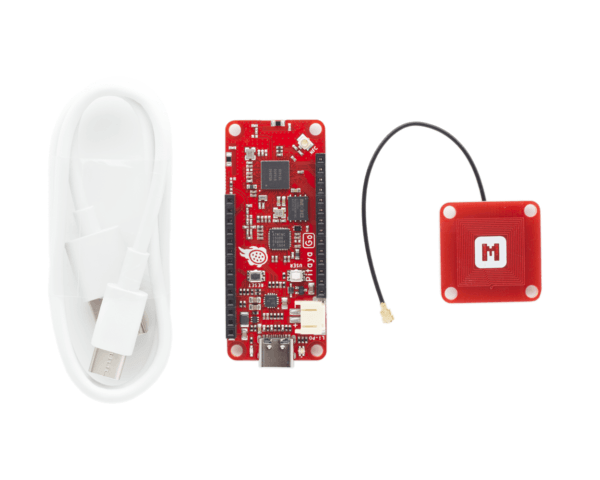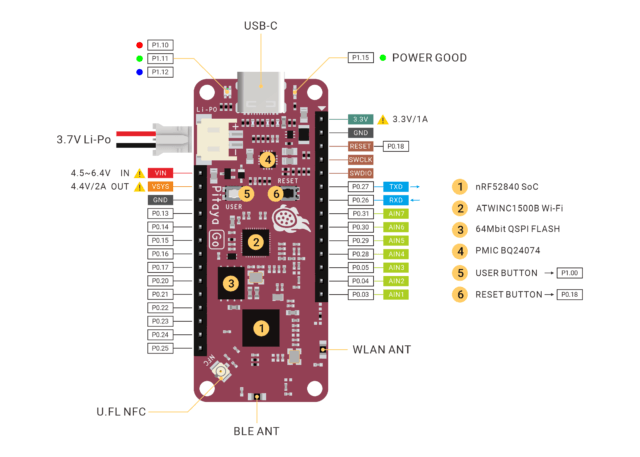One of the challenges in starting a new IoT project is the question of what connectivity to use. Depending on the nature of a project, there are several wired and wireless connectivity options that can be used to power a project and ensure it’s a success.
We have WiFi, Bluetooth, Zigbee, Zwave, LoRa, ZigFox, Thread, NB-IoT, 3G/4G, and others. You can use from anyone, but which one to use is another thing because most development board only support 1 or 2 of those.

Well, with the introduction of the Pitaya Go, you don’t have to worry so much about that decision. The Pitaya Go is an IoT development platform with multiprotocol wireless connectivity built-in.
The Pitaya Go is based on the Nordic’s high-end multiprotocol SoC nRF52840 and the Microchip’s extremely low power Wi-Fi network controller ATWINC1500B. The nRF52840 SoC is the most advanced member of the nRF52 Series SoC family, and it is fully multiprotocol capable with full protocol concurrency. It has protocol support for Bluetooth 5, Bluetooth mesh, Thread, Zigbee, 802.15.4, ANT and 2.4 GHz proprietary stacks.
So with the Pitaya Go, it is possible to run 2 or more IoT connectivity protocol concurrently thanks to the dynamic switching multiprotocol solution in the nRF528480 SoC. A useful application will be from transitioning from using the Bluetooth in a Smartphone to control or monitor Thread/ZigBee based sensor nodes. All you will need is this case is to have one Pitaya Go acting as the network gateway. See below video for application possibility.
The team behind the Pitaya Go is Makerdiary, which also released a similar development board called the nRF52840-MDK back 2018.
Pitaya Go is designed to be standalone. It comes with a battery charger and a power path manager. It features a 64Mbit ultra low power QSPI Flash memory, NFC-A Tag PCB Antenna, RGB LED (re-programmable), button, and GPIO through an expandable header socket. It also comes with a USB-C connector.

Pitaya Go offers a complete solution for wireless connectivity with IEEE 802.11 b/g/n WiFi 4, Bluetooth 5, Thread and Zigbee, that is specifically designed for the IoT. With Pitaya Go, I doubt if you will need another IoT board again. Maybe the addition of LoRa or any other LPWAN technology will be the ultimate bombshell.
Pitaya Go Features
- Nordic Semiconductor nRF52840 SoC
- 64 MHz Arm Cortex-M4 with FPU
- 1 MB Flash + 256 KB RAM
- Bluetooth 5, Bluetooth mesh, Thread, Zigbee, 802.15.4, ANT and 2.4 GHz proprietary
- Arm TrustZone Cryptocell 310 Security Subsystem
- Integrated USB 2.0 Full-speed Controller
- QSPI/SPI/TWI/I²S/PDM/QDEC/ADC support
- Integrated NFC-A Tag
- Microchip ATWINC1500B Wi-Fi Network Controller
- Shipped with the latest firmware 19.6.1
- IEEE 802.11 b/g/n 20 MHz (1×1) Solution
- Extreme low power with Shutdown Control
- On-Chip Network Stack to Offload MCU
- Supports Soft-AP
- Security protocols supported: WPA/WPA2 Personal, TLS/SSL
- Enterprise Security with WPA/WPA2 (802.11x)
- Network services: DHCP, DNS, TCP/IP (IPv4), UDP, HTTP, HTTPS, MQTT, etc.
- 64Mbit ultra-low-power QSPI Flash Memory
- Integrated Li-Po Battery Charger with Power Path Management
- Additional NFC-A Tag PCB Antenna
- User-programmable RGB LED and Buttons
- Dual Wi-Fi/Bluetooth 2.4G Chip Antennas
- Reversible USB-C Connector
- Li-Po Battery Connector
- Easily expandable dual 14-Pin Header Sockets
- Measures 2.4″ x 1.0″ x 0.3″ (60.96mm x 25.4mm x 7.6mm)
Pitaya Go is open-source, and the design files are freely available on the GitHub page. The board is available for purchase for $34.90 excl shipping on Tindie and Makediary online store.
The Makediary team has also released some exciting demo:
- Web Device CLI – a web-based terminal which can communicate with Pitaya Go via WebBluetooth. The principal aims of Web Device CLI are to help to get started quickly.
- Weather Client – Shows how to get weather information from openweathermap.org using Pitaya Go
More information about using the product is available on the Wiki and product page as well.

I enjoy writing about the latest news in the areas of embedded systems with a special focus on AI on edge, fog computing, and IoT. When not writing, I am working on some cool embedded projects or data science projects. Got a tip, freebies, launch, idea, gig, bear, hackathon (I love those), or leak? Contact me.
Support CNX Software! Donate via cryptocurrencies, become a Patron on Patreon, or purchase goods on Amazon or Aliexpress





This is really nice! I wonder if a version with a gsm modem would be economically viable vs a gsm modem over BT.
Why would you develop anything, let alone an IoT thingy, with GSM?
That would be almost as bad as designing an 8K TV with an analogue tuner.
EDGE still has the most coverage in EU. Particularly in remote/rural areas EDGE might be all you get. But for such a device several hundred of kbps would be sufficient.
The two people that need that could wire up one of the existing EOL GSM modules to the UART.
As long as the UART (1) is not capped at something silly like 115Kbps (nRF52840 has a 1Mbps UART so no issue there), (2) does not draw too much current due to e.g. a driver bug (like 52832 did https://devzone.nordicsemi.com/f/nordic-q-a/24397/nrf_log-uart-draws-300ua/96074).
That looks like a bug with the logging module and not the UART itself. Why would you have a logging module on a UART that is sending AT commands to a GSM module? Also if you are worried about 300uA you might be more worried that the GSM module consumes ~2mA even in sleep.
TL;DR; you wouldn’t design GSM into anything unless you’re some kind of *joker*.
> TL;DR; you wouldn’t design GSM into anything unless you’re some kind of *joker*.
In today’s episode of ‘let’s help dgp discover the wold’: https://store.arduino.cc/mkr-gsm-1400
I have always like the idea of having GSM module attached to IoT nodes, though not the best in terms of power consumption, but they will be fine for aggregating nodes. Nevertheless, with the rise of LPWAN technologies GSM modem won’t be needed again.
The NRF52840 is a great piece of TRX it has a really great link budget at 125kbps, in theory it should be capable of bridging several km of free space without additional PA/LNA.
This looks good as a debug tool if you happen to be using some of those 2.4GHz protocols but not really as an all-in-one *IoT* development platform. The interesting IoT projects are in the sub-1GHz bands and you don’t have any of those here.
what do you think of the FiPy?
Looks good as a development tool. I.e. if you’re developing something that has both WiFi and LoRa you could use that to run the main firmware code in a test harness on your desktop for doing debugging, validation, using valgrind to find why it keeps crashing and so on. 54 euro is a bit expensive unless you’re only making a one off though.
But the 54 € includes the engineering, maintenance and development of the firmware and other things in the Pycom environment …
Well, it’s open source and there are cheaper boards from others. But do they support open source like Micropython?
It’s ok and I could understand the problems of higher prices in private projects.
But in our industry, the few dollars make no difference – and we use many dozen of them. However, the support of Pycom is important (eg development, bugfixing and optimizing of libraries, …).
Not bad, but you could also use qca4020 single chip, though it may not match low power ble performance of nrf52840.
Yeah, sounds like a good alternative.